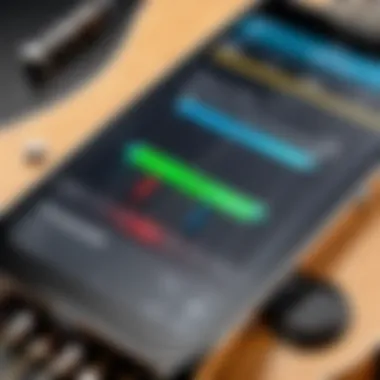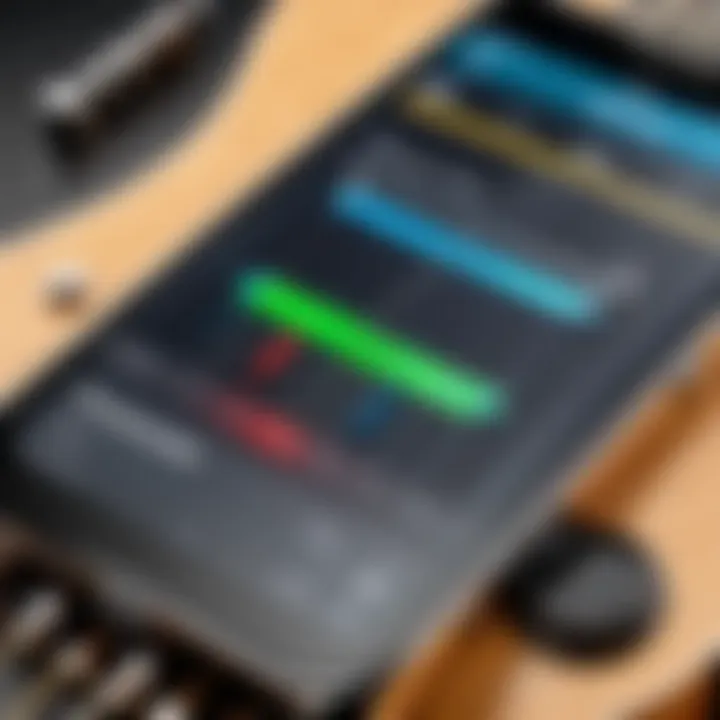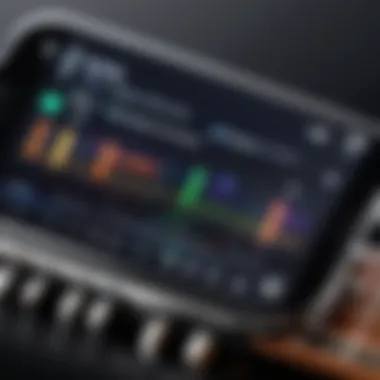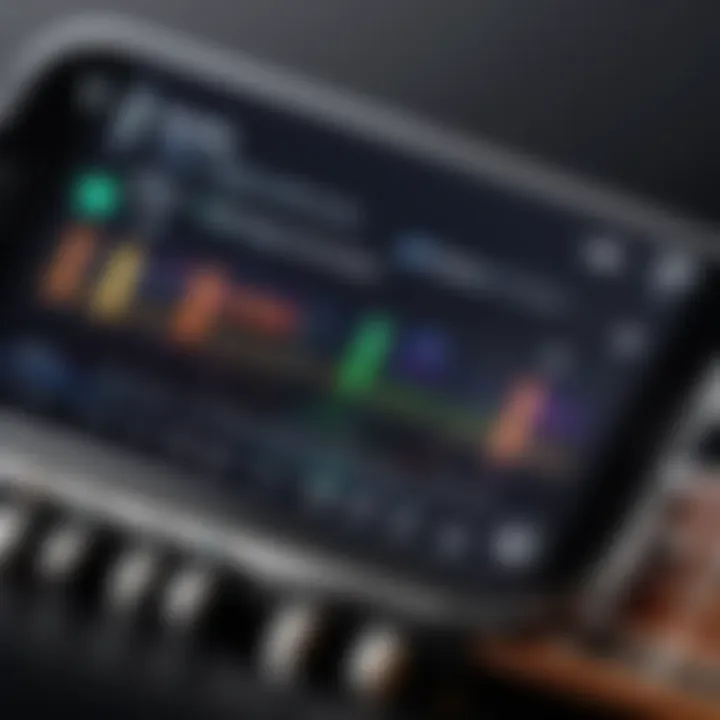Smartphone Guitar Tuners: A Complete Guide


Intro
Smartphone guitar tuners represent a significant evolution in the world of tuning instruments. With the proliferation of mobile technology, musicians now have compact and effective tools right in their pockets. These tuners offer an array of functions that extend beyond mere pitch detection, facilitating a connection to musical communities and resources through various applications. Their growing popularity showcases a shift in how musicians approach tuning today.
Understanding the functionality and benefits of smartphone tuners is crucial for both amateur and professional musicians. This guide aims to illuminate the key features, specifications, and user experiences associated with these devices, empowering readers to make informed choices in their tuning journey.
The unique fusion of portability and versatility positions smartphone guitar tuners as essential tools in modern music practice, and they deserve a closer examination.
Preface to Smartphone Guitar Tuners
The rapid advancement of technology has transformed how musicians tune their instruments. Smartphone guitar tuners have emerged as vital tools for both amateur and professional guitarists. These tuners leverage the power of mobile devices, integrating advanced technology that provides precise tuning solutions in a compact format. As music continues to intertwine with modern technology, understanding smartphone guitar tuners becomes increasingly necessary.
Defining Smartphone Guitar Tuners
Smartphone guitar tuners are applications designed to help musicians tune their guitars by using the device's microphone to detect pitches. They analyze the sound produced by the guitar strings and compare it to standard tuning frequencies. Users find these apps appealing due to their accessibility, as guitarists can quickly download a tuning app on their smartphones. This development significantly democratized access to reliable tuning methods, allowing musicians to maintain instrument accuracy at any given moment.
Evolution of Tuning Technologies
The journey of tuning technology dates back centuries, evolving from simple pitch pipes to intricate mechanical tuners. Early musicians relied on their ear and reference instruments for tuning. With the introduction of electronic tuners in the 20th century, tuning became more accurate and less subjective.
As technology progressed, guitar tuners evolved with features such as LED displays and visual tuning indicators. The smartphone era heralded a new wave of innovation, allowing sophisticated algorithms to be packed into mobile applications. This evolution means every guitarist today holds a powerful tuning device in their pocket, fundamentally altering how we approach instrument tuning.
"The introduction of smartphone guitar tuners has created a bridge between technology and musicianship, making tuning more accessible than ever before."
The significance of smartphone guitar tuners lies not only in their functionality but in how they changed the landscape of musical practice. The convenience and efficiency of these tools cannot be overstated, making them essential for serious musicians of all skill levels.
How Smartphone Guitar Tuners Work
Understanding how smartphone guitar tuners work is crucial for musicians seeking precision in tuning. These devices utilize advanced technology that blends hardware and software to provide an effective tuning solution. This section will unveil the inner workings of these tuners, uncovering the intricate processes that make them valuable tools for both beginners and seasoned players alike.
The Technology Behind Tuning
Smartphone guitar tuners rely on a combination of sound processing algorithms and digital signal processing (DSP). At the core, they analyze incoming sound waves from the instrument's microphone. The software identifies the pitch of the note being played by measuring the frequency and intensity of these waves.
Most tuners engage in real-time pitch detection. This means they constantly evaluate audio input to determine whether it aligns with standard tuning references, typically the notes of the western chromatic scale. The obtained frequency is then compared to the tuned reference and displayed to the user, often with visual feedback such as a needle gauge or LED indicators. This technology enables musicians to achieve a tuning accuracy that is usually on par with traditional tuners.
Some tuners include features that allow users to set frequencies for alternate tunings or non-standard temperaments. This flexibility widens the musical possibilities, catering to diverse genres and individual preferences.
Microphone and Frequency Analysis
The role of the smartphone microphone is foundational in the tuning process. It picks up sound waves emitted from the guitar strings when played. These sound waves have specific frequencies that correspond to musical notes. The microphone's quality can influence how accurately the tuner detects these frequencies.
Frequency analysis is the next step in the process. This involves breaking down the sound wave into its components, analyzing them to identify the fundamental frequency and its harmonics.
Once the software identifies the frequency, it displays whether the note is flat, sharp, or in tune.
The efficiency of this process relies heavily on the algorithms used in the app. Some tuners might struggle in noisy environments, as it can become difficult to isolate the sound of the guitar from background noise. Therefore, good microphone placement and a quiet setting can significantly enhance performance.
"With precise frequency analysis, smartphone guitar tuners are becoming indispensable for musicians. They offer tools not only to tune, but to explore musical expression."
This combination of technology and user-focused design makes smartphone guitar tuners a valuable addition to the toolkit of any musician.
Benefits of Using Smartphone Guitar Tuners
Smartphone guitar tuners offer a range of advantages that appeal to both amateur and professional musicians. They provide an innovative solution to traditional tuning methods, merging technology with musical practice. Understanding these benefits helps in recognizing their relevance in today’s music scene.
Portability and Convenience
One of the main attractions of smartphone tuners is their portability. Musicians can carry their smartphones easily, eliminating the need for a separate device. This integration allows for real-time tuning anywhere. Be it in a studio, a gig, or at home, having a tuning app readily available simplifies the process. Additionally, most tuning apps are user-friendly. The interface is designed for quick access to essential features, enabling musicians to start tuning right away without extensive setup.
The convenience extends beyond just having the tuner on hand. Many apps also provide features like metronomes or chord libraries, which can be beneficial for musicians practicing or performing. All these functionalities reside within the smartphone, making it an all-in-one tool. Overall, the accessibility of smartphone tuners enhances the overall musical experience, making it appealing for both newcomers and seasoned artists.
Cost-Effectiveness Compared to Traditional Tuners
Smartphone tuners stand out for their affordability. Unlike many traditional tuners that can be relatively pricey, a majority of tuning apps are free or available at a low cost. This cost-effectiveness makes them accessible for anyone, regardless of their budget. Considering that a musician may require multiple tuners for various instruments, the savings quickly assemble.


In addition to their initial cost, smartphone tuners often receive regular updates. This can include bug fixes or the addition of new features, which can enhance the user experience without the need for purchasing a new device. The longevity of the app contributes further to its overall value. Investing in a quality tuner app can save time and money in the long run.
Variety of Tuning Options Available
Smartphone tuners provide a wide range of tuning methods that traditional tuners may not offer. Musicians can select from chromatic tuning, open tuning, and special modes tailored to specific instruments. Furthermore, many applications allow customization based on personal preference or specific tuning standards.
The diversity of tuning options enables musicians to explore unique soundscapes. Whether adjusting to a specific pitch or experimenting with alternate tunings, smartphone tuners cater to various styles of music. Some apps even offer features to tune guitar strings individually or to adjust for certain types of music genres.
Overall, the adaptability and variety of smartphone tuners make them an effective solution for musicians looking to enhance their performance.
In summary, smartphone tuners combine portability, cost-effectiveness, and a rich set of features that can significantly improve musical practice. These qualities underscore their growing popularity in the music world, providing musicians with the tools they need for precision and creativity.
Types of Smartphone Guitar Tuners
Understanding the types of smartphone guitar tuners is crucial for musicians seeking the best tools for tuning their instruments. Each category has unique features, benefits, and drawbacks that cater to different tuning needs and preferences. This section delves into the three main types: chromatic tuners, strobe tuners, and app-based tuners. Comprehending these distinctions can significantly enhance a musician's tuning experience.
Chromatic Tuners
Chromatic tuners are perhaps the most versatile option among smartphone guitar tuners. They can recognize all twelve notes in an octave, making them suitable for tuning various stringed instruments, not just guitars. These tuners typically display the pitch of the note being played and show whether it is flat, sharp, or in tune. Because of their ability to tune to different scales, chomatic tuners are great for musicians who enjoy playing in non-standard tunings.
Key features of chromatic tuners include:
- Wide note recognition: Ability to tune to any note in the chromatic scale.
- Accuracy: Many chromatic tuners offer high precision, ensuring the instrument sounds its best.
- User-friendly interface: Usually equipped with clear visual indicators to guide musicians.
Considerations include:
- Learning curve for beginners: Some new musicians may find the various tunings and information presented overwhelming at first.
- Less suited for specific genres: While great for general use, they might not provide the specialized features desired by those within certain genres.
Strobe Tuners
Strobe tuners represent a more advanced type of tuning technology. They provide extremely high accuracy through the use of visual indicators that display a strobe-like effect. Musicians can see real-time pitch discrepancies through a rotating visual or light, making it easy to identify when a note is perfectly in tune.
Advantages of strobe tuners include:
- Exceptional accuracy: Often favored by professional musicians for high-stakes performances.
- Fine tuning capabilities: Ideal for instruments requiring precision, like orchestral strings.
- Real-time feedback: Musicians can receive immediate information on pitch adjustments.
However, strobe tuners also come with certain drawbacks:
- Complex interface: The advanced features may confuse those unfamiliar with tuning principles.
- Cost considerations: Typically more expensive than chromatic tuners, making them a less favorable choice for casual players.
"Strobe tuners are like the precision instruments of the tuning world. They show you exactly what you need to adjust for perfection."
App-Based Tuners
App-based tuners leverage smartphone capabilities to provide a convenient tuning experience. They range from simple and user-friendly apps to more advanced ones with various features. The flexibility and portability of app-based tuners appeal to many modern musicians.
Benefits of app-based tuners include:
- Accessibility: Many options are available for free or at a low cost, making them accessible to all.
- Additional features: Some apps include metronomes, pitch detection, and various tuning styles, adding value beyond mere tuning.
- Integration with smartphone functionalities: Easy to use in conjunction with other applications and tools.
Considerations when using app-based tuners:
- Quality may vary: Not all apps provide the same level of accuracy and effectiveness. Choosing a reputable app is essential.
- Dependence on device performance: Tuning may also depend on the quality of the smartphone's microphone, which can vary significantly.
By exploring these types of smartphone guitar tuners, musicians can make informed decisions tailored to their specific needs, enhancing their musical journey.
Popular Smartphone Guitar Tuner Applications
Smartphone applications have transformed the way musicians approach tuning their guitars. These applications offer a versatile, accessible solution for achieving optimal pitch accuracy without the need for bulky equipment. In this section, we will explore the leading smartphone guitar tuner applications, their features, and how they cater to both amateur and professional musicians alike.
Overview of Leading Applications
The market for smartphone guitar tuners includes a multitude of applications. Each app has its own unique features and user interface, allowing guitarists to choose one that suits their individual needs. Notable apps such as GuitarTuna, Cleartune, and Pano Tuner are popular among users.
- GuitarTuna: Offers a user-friendly interface and various tuning options, including standard, drop, and open tunings. It includes chord diagrams, making it great for beginners.
- Cleartune: Known for its high accuracy, Cleartune provides a customizable interface that allows for precise tuning adjustments. This app caters to musicians who require a more detailed approach to tuning.
- Pano Tuner: Features a chromatic tuner that is simple to use and effectively detects pitch in real time. It is a straightforward choice for those who prioritize functionality.


This broad selection of applications highlights the importance of user experience, as each guitarist may have different preferences regarding interface layout, tuning methods, and additional functionalities.
Feature Comparison of Top Apps
When assessing the leading smartphone guitar tuner applications, several key features are worth considering. These aspects determine the effectiveness and user satisfaction of each app.
Accuracy: The primary function of any tuner is to ensure precise tuning. GuitarTuna, Cleartune, and Pano Tuner have shown high accuracy rates, making them reliable options.
User Interface: A clear and intuitive interface can greatly enhance the user experience. GuitarTuna stands out in this regard with its visually engaging layout, while Cleartune offers a more technical interface for advanced users.
Tuning Modes: Different tuners provide various tuning options. GuitarTuna offers a wide range of tunings, while Cleartune allows custom tunings tailored to specific instruments.
Portability: All three applications are designed for ease of use on mobile devices, making them portable solutions for musicians on the go.
"When it comes to tuning your guitar, having the right application can greatly simplify the process and enhance your practice sessions."
Compatibility: Most applications are available on both iOS and Android platforms, ensuring a wide range of accessibility for users.
Accuracy and Reliability of Smartphone Tuners
In the realm of smartphone guitar tuners, the importance of accuracy and reliability cannot be overstated. Musicians and guitarists seek precision in tuning to ensure optimal sound quality and performance. A minor deviation in pitch can alter the overall music experience significantly. Therefore, it is vital for users to understand the factors that contribute to a tuner’s accuracy and how to set it up for best results.
Factors Affecting Accuracy
Several elements influence the accuracy of smartphone guitar tuners. One primary factor is the microphone quality of the device being used. The better the microphone, the more precisely it can detect pitch variations. This is crucial, especially in environments with background noise.
Another significant aspect is ambient noise. Loud surroundings can distract the mic, providing incorrect readings. Musicians should strive to tune their instruments in a quieter space to minimize disruptions.
In addition to these factors, the calibration of the tuner app plays a role. Many apps allow adjustments, but user familiarity with how to calibrate can often determine how well-tuning takes place.
Furthermore, loading of the software also impacts performance. Apps that are regularly updated typically offer improved functionality and bug fixes. Users should opt for well-reviewed, frequently updated tuner applications to ensure consistent accuracy.
Calibration and Setup for Optimal Performance
Setting up a smartphone guitar tuner requires attention to detail for optimal performance. Calibration is the first and foremost step. Users should check if their tuner app offers a calibration feature. Most tuners default to standard pitch (A440 Hz), but musicians may need to adjust this for alternate tunings or unique instruments.
Here are some steps to follow for proper calibration and setup:
- Open the Tuner App: Ensure the app is the latest version.
- Select Calibration Mode: Navigate to tuning settings and check for a calibration option.
- Adjust Frequency: If tuning to a different pitch, adjust it according to the desired frequency.
- Test the Mic: Play a few notes and check if the tuner accurately detects pitches. If there's a lag or inconsistency, try positioning the device closer to the instrument's sound hole.
- Eliminate Background Noise: Move to a quieter area to avoid interference.
By following these steps, musicians can enhance the performance of their smartphone tuners, ensuring precise tuning which is essential for musical integrity.
Accurate tuning directly influences overall performance quality, making reliability in a tuner imperative for musicians.
Ultimately, understanding the factors that affect accuracy and implementing correct calibration methods empowers musicians to leverage smartphone tuners effectively, bridging the gap between accessibility and precision.
Comparing Smartphone Tuners with Traditional Tuners
When musicians seek to perfect their sound, the choice of tuning device plays a vital role. This section explores the nuances of smartphone tuners compared to traditional tuners. Understanding the benefits and drawbacks of each can significantly affect a user’s experience and productivity in musical endeavors.
Benefits and Drawbacks
Smartphone tuners offer significant advantages over traditional counterparts. The most noted benefit is portability. Musicians can keep their smartphones with them, eliminating the need to carry extra devices. Additionally, the variety of features in apps enhances the user experience. Many applications provide different tuning options, record settings, and even audio samples to guide users.
However, there are challenges. Accuracy can vary. Traditional tuners often deliver consistent tuning results, while smartphone tuners depend on the quality of internal microphones. Environmental factors may also interfere with tuning accuracy, where a more controlled setting benefits traditional tuners.
Traditional tuners have a solid reputation for reliability. Their specialized hardware is designed specifically for tuning purposes. Many musicians prefer the tactile feedback of knobs and buttons rather than touch screens.
- Pros of Smartphone Tuners:
- Cons of Smartphone Tuners:
- Pros of Traditional Tuners:
- Cons of Traditional Tuners:
- Portability and convenience
- Extensive app features
- Cost-efficient options
- Potential accuracy issues
- Dependence on smartphone quality
- High reliability and consistency
- Focused design for tuning tasks
- Bulkier and less portable
- Often more expensive


User Preferences and Experience
User preferences play a significant role in determining which tuner is used. Many musicians appreciate smartphone tuners for their versatility. They can easily switch between tunings or modes, allowing for immediate adjustments when a song changes key. The interface of these apps can also make tuning visually intuitive.
Conversely, some musicians feel more comfortable with traditional tuners. They trust the consistency and build quality of dedicated tuners. Musicians engaged in live performances also prefer traditional options for their reduced lag and greater reliability in noisy environments.
Whether opting for smartphone or traditional tuners, user experience varies widely. Each musician brings unique needs, whether prioritizing convenience or fidelity. One general sentiment among users is the desire for ease of use, leading many to explore hybrid solutions.
"Musicians often choose based on their situation—whether rehearsing, playing live, or recording, the tuning choice reflects their immediate needs."
User Experience with Smartphone Guitar Tuners
The user experience with smartphone guitar tuners is pivotal in determining their effectiveness and popularity among musicians. This section scrutinizes various aspects that influence the overall interaction between the user and the tuning application. Key factors include usability, accessibility, and response time, all of which contribute to the satisfaction of both beginners and seasoned players. Understanding how musicians perceive these tools and what specific features they value can shed light on the advancements in tuning technology.
Feedback from Musicians
Feedback from musicians provides invaluable insights into the practical aspects of smartphone guitar tuners. Many musicians praise the portability of these apps, allowing for quick tuning adjustments during live performances or rehearsals. The convenience of having a tuner readily available on their phone simplifies the process, making it accessible even to those who are not traditionally savvy with music technology.
Moreover, users often highlight the accuracy of these tuners. With features such as real-time pitch detection and visual displays, smartphone tuners can be reliable for both amateur and professional settings. However, some musicians mention issues with microphone sensitivity, especially in noisy environments, which can hinder the tuning process.
"Having a tuner on my phone has changed how I practice. I can tune up before every session without carrying more gear."
It's critical to note that some musicians still prefer traditional tuners due to their reliability in various settings. The user feedback often reflects a mix of appreciation for technological advancements and the desire for the consistency found in dedicated devices. This duality informs developers about necessary improvements and what elements speakers value most.
Case Studies and Real-Life Application
Exploring case studies and real-life applications of smartphone guitar tuners reveals how these tools fit into musicians' lives. For instance, a local band might use an app like GuitarTuna while on stage, allowing quick adjustments between songs. This flexibility can enhance performance flow.
In contrast, solo performers often utilize tuners like Cleartune during practice sessions to hone their sound. The application acts as a learning tool, helping musicians recognize pitches and sharpen their skills.
Additionally, one notable instance involves an educator integrating smartphone tuners into a music curriculum. The instructor observed that students were more engaged when using their devices, turning tuning into an interactive learning experience. This shift not only improved students’ tuning abilities but also increased their interest in music technology.
Overall, user experiences serve as a reflection of how smartphone guitar tuners are integrated into both casual and professional environments. Their impacts are felt in various facets, from ease of use to fostering a deeper understanding of music for learners.
\n
Future Trends in Smartphone Tuning Technology
The future of smartphone guitar tuners promises to be both exciting and transformative. As technology continues to advance, musicians can expect numerous enhancements in the accuracy, functionality, and user experience of these tuning devices. Understanding the future trends in this field is vital for musicians seeking to improve their skills and adapt to new developments. A critical examination of emerging technologies, such as artificial intelligence and improved sensor capabilities, will offer insight into how these tools can better serve the needs of musicians.
Emerging Technologies and Innovations
Recent years have seen remarkable innovations in smartphone tuner technologies. Several key trends are shaping the landscape:
- Enhanced Microphone Sensors: New smartphones come equipped with advanced microphone technology. These improvements allow for more precise sound capture, crucial for accurate tuning. As microphone sensitivity increases, tuners can detect pitches with much greater accuracy, leading to better performance.
- Real-Time Audio Processing: Enhanced computational power in mobile devices enables real-time analysis of audio signals. This capability helps tuners react instantaneously to variations in pitch, providing musicians with immediate feedback.
- Integration with Other Music Apps: Future tuners may increasingly incorporate connectivity features, allowing for seamless integration with music production apps and tools. This integration can significantly enhance the user experience and increase the versatility of smartphone tuners.
- Improved User Interfaces:
As user experience becomes increasingly important, developers are focusing on creating more intuitive interfaces. Simple navigation, customizable settings, and engaging visuals can make the tuning process more accessible to users at all skill levels, making technology less intimidating.
Each of these technological advances aids in facilitating better outcomes for musicians, thereby highlighting the importance of staying abreast of these developments.
Influence of AI in Music Tuning
Artificial intelligence holds transformative potential in various music-related fields, including tuning. The implications of AI in smartphone guitar tuners can be summarized in several areas:
- Smart Learning Algorithms:
AI can learn a musician's tuning preferences over time. By analyzing past tuning adjustments, it can provide personalized suggestions, enhancing the whole experience for users. - Pitch Detection and Correction:
Advanced algorithms can more accurately identify pitch discrepancies and correct them automatically. This could enable near-instantaneous tuning stabilization, giving musicians confidence while they play. - Predictive Analysis for Custom Tunings:
AI can analyze popular tuning patterns and recommend alternative tunings based on style or genre. This feature can expand a musician's creative possibilities without significantly increasing their workload.
By leveraging AI, future smartphone tuners may become tools that not only assist in finding the right pitch but also inspire musicians to explore innovative avenues in their craft.
End
The conclusion of this article encapsulates the significance of smartphone guitar tuners, providing a comprehensive assessment of their impact on both amateur and professional musicians. As we have explored various aspects of these innovative tools, it becomes evident that their growing popularity is not merely a trend but a reflection of the evolving needs within the music community. In an age where convenience and accessibility are paramount, smartphone guitar tuners offer solutions that align well with contemporary practices.
Recap of Key Insights
Throughout the article, several key insights have emerged:
- Functionality and Variety: Smartphone guitar tuners come in various forms, including chromatic, strobe, and app-based tuners, catering to a wide range of tuning needs.
- Technological Advances: The integration of sophisticated technology within smartphones allows for precise tuning capabilities that rival traditional tuners.
- User Experiences: Feedback from users highlights high satisfaction rates, emphasizing the convenience and portability inherent in these applications.
- Future Innovations: As technology progresses, we can expect ongoing advancements that will further enhance the capabilities of smartphone tuners.
These insights underscore the relevance and practicality of smartphone guitar tuners in today's musical landscape.
Final Thoughts on Smartphone Tuners
In summary, smartphone guitar tuners have transformed the way musicians approach tuning. Their ability to combine advanced technology with user-friendly interfaces makes them indispensable tools for guitarists. When considering a tuner, users should evaluate their specific needs and preferences, choosing an application that offers the best blend of accuracy, features, and usability.
In closing, adopting smartphone guitar tuners not only streamlines the tuning process but also enriches the overall playing experience. As musicians continue to embrace these devices, the future of music tuning looks promising, with further developments on the horizon.



